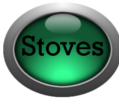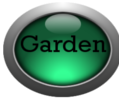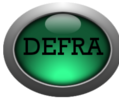Menu
Our other websites
KNOWLEDGE BASE
WHAT IS A REGISTER PLATE, HOW IS IT FITTED AND WHY DO I NEED ONE?
Fitting a wood burning stove or fire carries no stipulation that the work cannot be carried out by a DIY enthusiast. All work however does have to comply with part J of the building regulations. These regulations can be seen by clicking here.
If this work is not carried out by a competent person (E.G a HETAS installer) it must be inspected by someone from your local councils Building Control Department. Solid fuel produces Carbon Monoxide. This gas, if unchecked is deadly.
Wood burning stoves and fires are, in themselves, fairly simple. The wood, or solid fuel is fed into the chamber, set light to, and the smoke and exhaust fumes escape up a flue to outside air. It is however, absolutely vital, that during this process no heat escapes through any gaps or cracks. Wood burners and other solid fuel fires, including open coal fires, create an immense amount of heat. If this heat is allowed to escape before it gets to open air it can very easily cause a fire and it is imperative you have any existing flue checked by a qualified engineer before attempting to fit a wood burning stove or fire.
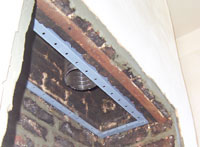 You can just see, at the top of the fireplace, the new flexible flue liner hanging down. The first job, while the fireplace was empty, was to install a steel frame to hold what is called a register plate. The register plate stops loose objects falling from inside the stack into the fireplace and also keeps the flue insulation in place. It seals the chimney stack and prevents any smoke or other flue gases getting back into the room. It should be made of a non flammable material and it fits round the wood burner flue pipe while also blocking off the opening to the stack completely. Proprietary steel register plates can be bought from the fire supplier and they will measure the fireplace opening and position of the flue for you. You will still need to install a frame or some other means of holding it in place.
You can just see, at the top of the fireplace, the new flexible flue liner hanging down. The first job, while the fireplace was empty, was to install a steel frame to hold what is called a register plate. The register plate stops loose objects falling from inside the stack into the fireplace and also keeps the flue insulation in place. It seals the chimney stack and prevents any smoke or other flue gases getting back into the room. It should be made of a non flammable material and it fits round the wood burner flue pipe while also blocking off the opening to the stack completely. Proprietary steel register plates can be bought from the fire supplier and they will measure the fireplace opening and position of the flue for you. You will still need to install a frame or some other means of holding it in place.
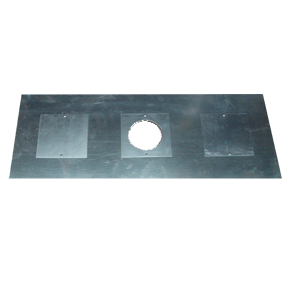 Some people use fire proof board for register plates (as in the pictures further down in this article) because it is easy to cut, very light and easy to position but many people prefer to buy a pre-cut steel register plate with access panels (see picture left). This is useful in case of a requirement to get access to the chimney.
Some people use fire proof board for register plates (as in the pictures further down in this article) because it is easy to cut, very light and easy to position but many people prefer to buy a pre-cut steel register plate with access panels (see picture left). This is useful in case of a requirement to get access to the chimney.
These plates come in standard sizes and can be trimmed to fit if neccessary. They also come with the fitting frame
Next the flue outlet is fitted to the top of the wood burner. To stop heat escaping from any gaps the flue outlet bracket sits in a slight recess at the top of the wood burner and a length of fire rope is placed in between the two.
As the flue outlet is tightened down onto the top of the wood burner, the fire rope is squashed into place.
Fire rope is also used as the seal between the wood burners door and the frame it butts up to. This is in place when you purchase the woodburner.
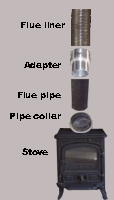 Having measured the distance from the top of the fire (inside the flue outlet) to a point at least 100 mm above the top of your new register plate frame, you can cut off the surplus flue liner and cut the wood burner flue pipe to length.
Having measured the distance from the top of the fire (inside the flue outlet) to a point at least 100 mm above the top of your new register plate frame, you can cut off the surplus flue liner and cut the wood burner flue pipe to length.
If you use a steel register plate it is better (if it will not cause an eyesore) to keep the joint between flue pipe and flue liner, below the register plate
A special collar, or adapter is used to join the top of the flue pipe to the bottom of the flexible flue. Sit the flexible liner into the collar so it is located centrally. Tighten the self tapping screws round the collar to hold the liner in position and to secure the collar to the liner. Another length of fire rope is inserted into the collar and fitted around the circumference of the flue pipe. Fire cement is now rammed into the collar so there are no air voids.
The joint is then smoothed off and left for a while. Fire cement 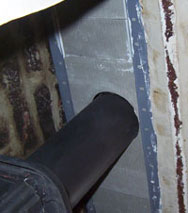 goes hard when exposed to heat. Many installers use fire mastic for this joint.
goes hard when exposed to heat. Many installers use fire mastic for this joint.
The register plate can now be fitted into the frame. The offcut of the flue pipe can be used as a template and a line drawn round it. This circle can be cut out with a jig saw, pad saw or coping saw. This is done for the two parts of the plate surrounding the flue pipe and straight lengths are fitted to fill any gaps. Fire cement can be bought from us or at any good builders merchants.
Seal the joints and gaps of the register plate with some fire mastic.
Finally, place a chimney "pot hanger" over the remainder (maximum 150mm) of flexible flue liner and secure it in placet.
Lift the register plate to check the adapter joint periodically.
DON'T FORGET TO HAVE YOUR CHIMNEY SWEPT BEFORE THE INSTALLATION AND REGULARLY AFTERWARDS!
SEE OUR RANGE OF REGISTER PLATES AS WELL AS FLUE PIPES, CHIMNEY LINERS AND EVERTHING ELSE YOU NEED TO INSTALL YOUR STOVE BY CLICKING HERE.
Please note these articles are inended for GENERAL GUIDANCE ONLY. We do not provide advice over the phone or by email to customers looking for a free consultancy service to help them with a DIY install, and if you have bought your stove, chimney liner or other installation kit from another supplier, we will not answer any questions or otherwise get involved in disputes or queries. Please check with your local council building controls department before commencing any work if you are unsure of the regulaions.
wood burning stoves and multi fuel stoves


